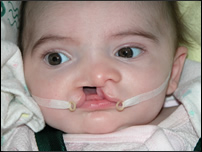Cleft lip and/or cleft palate are anomalies that occur when a baby’s lip and/or palate do not fully form prior to birth. A cleft lip is a separation of the two sides of the upper lip. The separation often includes the gum line and/or bones of the upper jaw, as well as the nose.
A cleft palate is an opening in the roof of the mouth in which the two sides of the palate did not fuse, or join together. The mouth and the nose are no longer separated and become one cavity – you probably see this most dramatically when your baby eats.
 |
| Before |
Cleft lip and cleft palate can occur on one side (unilateral cleft lip and/or palate), or on both sides (bilateral cleft lip and/or palate). Because the lip and the palate develop separately, it is possible for the child to have a cleft lip or a cleft palate alone, or both together.
These clefts, or separartions, normally are present in early fetal development. The lip usually closes by 5 to 6 weeks after conception, and the palate by 10 weeks. The lip or the lip and palate together fail to close in approximately 1 in every 1,000 babies born. Some ethnic groups (such as eskimos or asians) have a higher number of babies with cleft lip. Males are affected more frequently than females.
 |
| After |
Cleft palate occurs alone less often, appearing in approximately 1 in every 2,000 babies. Unlike the risk for cleft lip/palate, the risk for isolated cleft palate appears to be similar across all racial groups. And unlike cleft lip/palate, there is a higher incidence of cleft palate alone in females.
Causes of Cleft Lip and Cleft Palate
The specific causes or risk factors for developing cleft lip or palate are not well understood. Potential causes/risk factors include:
- Genetics
Sometimes cleft lips/palates run in families. - Syndromes
A cleft lip and/or palate may occur with other birth defects as part of a genetic syndrome. - Environment
Some studies suggest a link between maternal drug use (such as antiseizure medication), alcohol abuse, or smoking; maternal illness or infection; or deficiency of folic acid may be related to the development of a cleft lip or palate. - Spontaneous
Most cleft lip/palate anomalies occur randomly and without any clear cause or fault.
Treatment for Cleft Lip and Cleft Palate
Cleft lip and/or palate is typically corrected with surgery, but each child may require a variety of services including dental/orthodontic care or speech therapy. The Cleft and Craniofacial Center team will work with you, your child and your pediatrician to determine the best treatment plan for your child. Treatment options include:
See Our Patients Before and After Surgery
Contact Us
To contact the Cleft and Craniofacial Center or a team member, please call 585-273-FACE.
